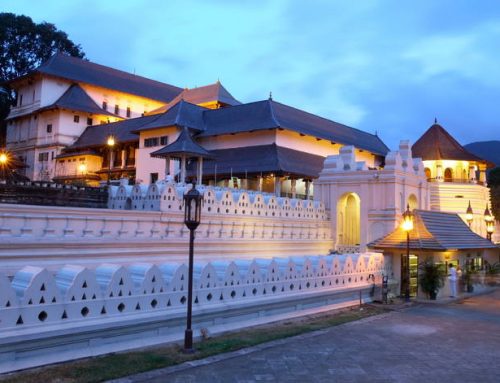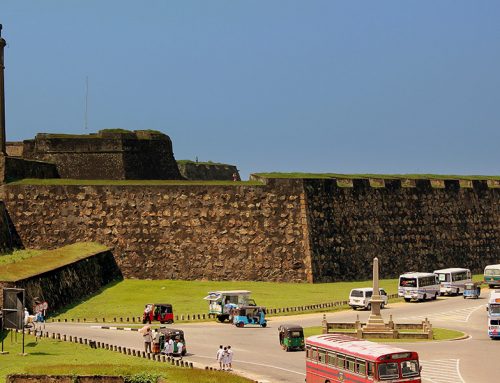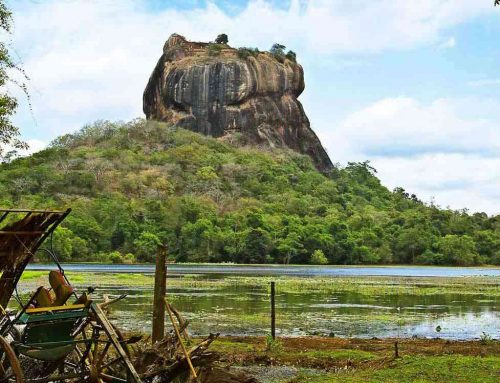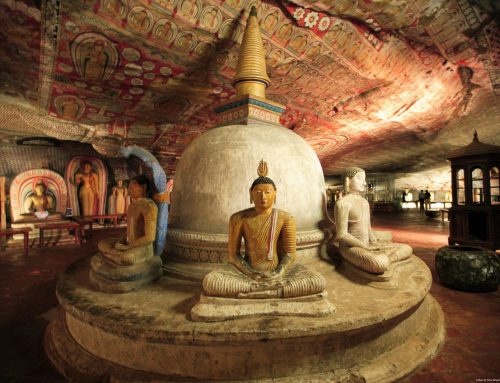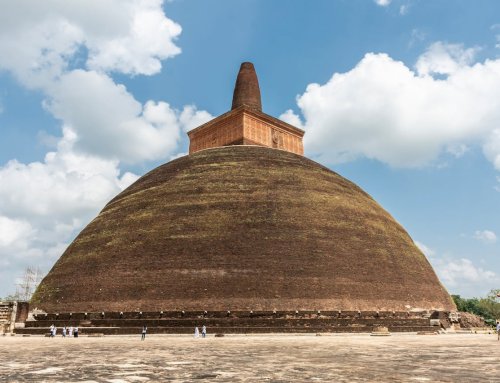Polonnaruwa, Sri Lanka’s splendid medieval capital was established as the first city of the land in the 11th Century, A.D. It replaced Anuradhapura, which was plundered, made desolate and laid hopelessly bare to the invading armies from South India.
To see many of the relics excavated from the site such as the stone lion which once guarded the palace of King Nissanka Malla, or the fine Hindu bronzes unearthed from the ruins of the Siva Devale Temple – you may have to visit the National Museum in Colombo, where they are kept. However, with the opening of the new Polonnaruwa Visitor Information Centre and its museum in 1998/9 some of the key exhibits were scheduled to return to the place where they were discovered.
Polonnaruwa Highlights
“Monkey Kingdom”
Polonnaruwa has been in the limelight recently with the release of the Disney documentary movie “Monkey Kingdom” in over 12,000 US Cinemas in April 2015. The film documents the life of a troop of wild toque-macaque monkeys locally known as “Rilaw” while the entire set was based around the ancient kingdom of Polonnaruwa.According to our current minister of Tourism, the documentary movie portrays the island as an exotic destination that is filled with natural beauty and highlighted by heritage sites such as Polonnaruwa. The film also gives proper attention to these types of monkeys and it shows their association with Polonnaruwa and their behavioural patterns which is a perfect way to educate locals and tourists alike about conserving these animals.
The kingdom’s grandeur and structural masterpieces are a true treasure to the country while the amalgamation of nature and animals adds the fine touch to the boosting tourism industry that the country has always hoped for.
Filmed around Polonnaruwa the movie “Monkey Kingdom” was directed by Mark Linfield and Alastair Fothergill who were also well known for their blockbusters such as “Earth” which grossed more than 100 million dollars at the box office and their wildlife documentary “Chimpanzee” which grossed almost 35 million. The documentary portrays these monkeys as a fascinating species that also requires conservation. Most locals however, don’t pay much attention since they are seen quite commonly roaming around. The main aim of the film is to create awareness among locals and promote these monkeys as animals that we should safeguard.
It was said that a part of box office receipts will be donated to Conservation International which is an American non-profit environmental organization dedicated to protect nature. Dr. Wolfgang Dittus who is a scientific consultant has been studying these macaque monkeys of Sri Lanka for nearly half a century. His studies are considered as one of the longest running studies which is connected to wild primates. When creating the documentary, Dr. Dittus had assisted in selecting the monkey characters and interpreting their behavioural patterns. The film is narrated by the Emmy award winning actress Tina Fey while it was released internationally to coincide with Earth Day.
With the popularity of the documentary, we believe that Sri Lanka, especially Polonnaruwa will be a well known tourist destination that will attract many tourists from around the world, especially from the US.
Parakrama Samudraya in Polonnaruwa
Parakrama Samudraya (Sinhala: Sea of Parakrama) built by King Parakramabahu the great, is the largest ancient man-made rainwater reservoir in Sri Lanka while it dominates the western flank of the Polonnaruwa district. The great reservoir spreading over an area of 2500 hectares and having a capacity of 134 million cubic meters of water is the lifeline to the agricultural district of Polonnaruwa and its surroundings. The ancient city of Polonnaruwa, 122 hectares in extent, spreading out to a distance of 5km from north to south and 3km from east to west, is also the beneficiary of cooling breezes of the Parakrama Samudraya.Within proximity of the Parakrama Samudraya are the ruins of the Kings (King Nissanka Malla) Council Chamber on whose pillars are inscribed the status and titles of various officials of the kingdom.
Statue of King Parakramabahu in Polonnaruwa
On the Southern side of the Parakrama Samudraya and South of picturesque lakeside Rest house is another well known Polonnaruwa monument: a striking rock carved statue of a man of noble disposition holding a stack of manuscripts.The statue has generated speculations and arguments concerning its identification. The archaeologists haven’t arrived at a concrete conclusion.The sculpture that rises at a height of 3.5m is believed to be that of King Parakramabahu the great.It could also very well be a representation of the sage Pulasti, after whom the city was named Pulastinagara. Pulastinagara (Sinhala: City of Pulasti) is the pali version of the Sinhala name Polonnaruwa.
Palace of King Parakramabahu in Polonnaruwa
Enclosed by ramparts that are four leagues long and seven leagues wide, the Royal Citadel has many interesting monuments. Palace of King Parakramabahu must have been an imposing edifice once, richly decorated and seven storeys high. The remaining walls of the palace are of extra-ordinary thickness and the drainage system is intriguing. A little further on, is the handsome royal bath, the Kumara Pokuna. Across the way is the beautiful Royal Audience Hall – embellished with lion portals, graceful pillars and a moonstone. (a delicately carved stepping stone).The structural techniques of this period were the same as those of the Anuradhapura period, but there was a greater use of lime mortar, which enabled the building of brick structures of dimensions that were never before attempted.
Potgul Vehera in Polonnaruwa
At the southern end of the city, i.e. 100m south of the statue of King Parakramabahu, outside the Royal Garden of Nandana Uyana is the Potgul Vehera, or the Library Monastery’. A central square terrace houses the principal monument, a circular shrine or library where the sacred books were deposited. It is surrounded four small dagobas.The superior acoustics of Potgul Vehera leads to the conclusion that the library had doubled up as an auditorium on occasions to read the books, read the tenets of Buddhism and chant the blessings called “Pirith” The buildings called Potgul Vihara or library that was utilized for the same purposes as the shrine at Polonnaruwa, can be seen in some of the Buddhist monuments too.
Shiva Devale in Polonnaruwa
Shiva Devale 1 A Hindu Temple of chaste and restrained line dedicated to God Shiva of 12th century vintage.Shiva Devale 2 Past the north gate of the citadel is the 11th century Hindu temple built entirely of stone. Within in the sanctum is a stone carved lingam or phallus, a symbol of Hindu god Diva. In front of the temple is the Nandi bull, God Shiva’s vehicle.
Thuparama in Polonnaruwa
Thuparama, a brick-built gedige (Sinhala: vaulted shrine) is in a fine state of preservation. Thuparama, the oldest image house at Polonnaruwa goes back to the reign of King Vijayabahu the first (1055-1110 A.D.).A brick base is about one meter high with three projections that once carried an image of Buddha, which is now simply a pile of bricks. The stone images in the Thuparama date back to the Anuradhapura period.
Vatadage in Polonnaruwa
Vatadage, a circular relic house possesses an elegance and beauty that is rare even in ancient Sri Lanka. In line with the outer circle of stone pillars is a tastefully ornamented screen wall patterned with four petalled flowers.The access stairs at the cardinal points are beautifully carved. At the head of each flight is a Buddha statue in stone. Vatadage is lavished with moonstones and guard stones.
Nissanka Lata Mandapaya in Polonnaruwa
Nissanka Lata Mandapaya, built by King Nissankamalla, is an innovative work of art depicting the splendour of classical architecture. The pavilion was believed to be used for chanting Buddha’s teaching while the inscription at the pavilion reveals that the king used to listen to the chanting of pirith, which were Buddhist blessings.The Nissanka Lata Mandapaya pavilion which is surrounded by Buddhist railings, houses a bubble shaped small dagaba, without its upper part, while it is carved out of stone in the centre. It is possible, the stone carved stupa used to hold the relic casket during pirith chanting.
The Sathmahal Prasada in Polonnaruwa
The Sathmahal Prasada or the seven storeyed edifice is constructed in a stepped pyramidal form that contains seven square levels. According to the archaeologists, the layout of the edifice resembles Vat Kukut at Lamphun, Thailand built in the eight century.The identity and the purpose of the Sathmahal Prasada haven’t yet been proven. According to the historical chronicles of Sri Lanka, King Parakramabahu the Great had built a stupa in the area and some scholars have assumed the building was in fact a stupa. A similar building discovered in Anuradhapura is known by the name of Nakha Vehera.
Hatadage and Atadage in Polonnaruwa
Hatadage and Atadage are Sacred Tooth relic temples in Polonnaruwa built by king Wijayabahu and king Nissankamalla. The 11th century Atadage and the 12th century Hatadage both housed the Sacred Tooth Relic of Buddha. Both are handsome structures embellished with fine carvings.Having liberated Sri Lanka from the Dravidian invaders, King Vijayabahu setup his capital at Polonnaruwa and built the Atadage so that the sacred tooth relic of Buddha and the Bowl relic could be deposited. The ground floor was the image house.
The Atadage, an enlarged version of Hatadage, was built by King Nissankamalla to house the Sacred Tooth Relic and Bowl Relic. The impressive building with the ground floor serving as an image house is accessed by a masterfully carved doorway. Inscriptions by King Nissankamalla inscribed on the walls are now discoloured.
Gal Potha (Stone Book) in Polonnaruwa
Gal Potha is a massive 26 ft slab of stone that lies by the side of the Hetadage in which King Nissankamalla had his own deeds recorded in stone.The inscriptions also contain particulars of King Nissankamalla’s genealogy and his wars with Dravidian invaders from South India. The inscription itself says that the slab of stone was brought to the location from Mihintale.
The inscription has been of great assistance to the scholars since it also reveals evolution of the Sinhala script. On the side of Gal Potha are two stone carved Elephants sprinkling water on goddess Lakshmi, the Hindu Goddess of Prosperity.
Pabalu Vehera in Polonnaruwa
Rankoth Vehera in Polonnaruwa
Rankoth Vehera built by King Nissankamalla, is the largest dagoba in Polonnaruwa. Rankoth Vehera had followed the traditions of early stupas built in Anuradhapura. The enormous dagoba that measures 550 ft. in girth belongs to the Alahana Pirivena monastery complex.Around the enormous dagoba are image houses and flower alters set in the wide sand terrace surrounding the stupa. At the four central points are Vahalkadasa or front entrance enclosures built of brick, with four flights of steps providing admission to devotees.
The inscription on the stone-seat in front of the dagoba says that King Nissankamalla used to supervise the construction of the Rankoth Vehera. Another inscription on the platform to the south narrates that King Nissankamalla used to worship the dagoba from the pavilion.
Lankatilaka in Polonnaruwa
Kiri Vehera in Polonnaruwa
Kiri Vehera is just ahead of Lankatilaka. The milk-white shrine was named Kiri Vehera (Sinhala: Milk coloured stupa) for its exterior of gleaming white, built by Queen Subhadra, a consort of King Parakramabahu. Noted for its perfect proportions, Kiri Vehera is the best preserved of Sri Lanka’s dagobas. A three-chambered relic bloc that was found while excavating a large mound to the east of Kiri Vehera reveals the structure and composition of relic chambers during the Polonnaruwa period. In addition to that, the excavations have unearthed many mounds which were originally minor stupas containing the corporeal remains of the royal family and the prelates of the monastery.On the lower terrace towards the west of Kiri Vehera are ruins of a chapter-house or a assembly hall for the Buddhist monks.
Gal Viharaya in Polonnaruwa
Gal Viharaya or the Rock Temple, which is unparallel among such ancient monastic edifices, takes the form of a group of colossal Buddha statues carved out of a granite boulder. Most prominent is the standing image, 7m (23ft) tall.Next to it is an enormous 14m (46ft) reclining Buddha. The head rests on the right palm, while the left hand is stretched along the left side of the body. The dent on the pillow caused by the weight of the head and the slightly drawn angle in the left leg adds life to the superb rock carved work of poise and balance.
Next to the reclining Buddha statue is the standing figure of Buddha. According to archaeologist Dr. Senerath Paranavitana, the pose and the facial expression of Buddha shows his supreme compassion towards the suffering.
The seated Buddha statue on the southern end with a backrest decorated in an arch is carved in front of the seat.
Nelum Pokuna (Lotus Bath) in Polonnaruwa
Tivanka Image House in Polonnaruwa
Tivanka image house, located 400m north of the Lotus Pond, is so named following the thrice bend yet towering The Buddha Statue therein. The head and neck of the Buddha statue have now come off. Tivanka means three bends in Sinhalese. The Buddha statue is bent at three places: at the knees, at the waist and at the shoulders. The inner walls as well as the outer walls of the image house are exquisitely decorated.The paintings on the outer walls are purely decorative with figures of lions, gansas and dwarfs. The murals on the inner walls are masterpieces. Yet those 12th century frescoes depicting scenes from tales of previous lives of Buddha have now faded. According to the scholars these paintings depict a blend of popular and classical styles.


